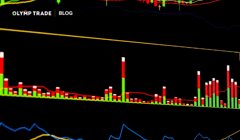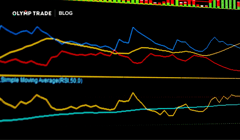
MACD stands for Moving Average Convergence/Divergence. This indicator acts both as a trend indicator and oscillator and helps to assess and forecast instrument price fluctuations. It was first described in 1979 by Gerald Appel in his book “Systems and Forecasts.” Later, Thomas Esprey added a histogram to the MACD indicator in 1986.
Contents:
- How Can You Use the MACD in Trading?
- Accessing the MACD Indicator and MACD-based Advanced Tools
- MACD Indicators’s Signals
- Try It All Out
Interact with the underlined words and green dots to get additional details and explanations.
Additional context for the visuals.
Explanations and definitions of terms.
How Can You Use the MACD in Trading?
The MACD consists of two lines (MACD line and signal line) and the histogram. These two lines are the moving averages.
The fast MACD line is the difference between two exponential moving averages with periods of 12 and 26.
The signal line is a smoothing MACD line. So we need to apply another exponential moving average with a period of 9 to the MACD line.
MACD line = EMA12 (Price) - EMA26 (Price)
Signal line = EMA9 (MACD line)
As we can see, the Signal line is a slow line and the MACD line is a fast line.
The MACD histogram is just the difference between a MACD line and a signal line. Here is the formula:
MACD histogram = MACD line - Signal line
The MACD histogram is usually fluctuating around the 0 level. If it rises, the spread between the MACD line and a signal line is increasing.
Accessing the MACD Indicator and MACD-based Advanced Tools
The MACD indicator is available in the list of Indicators to traders of any status including Starter.

Additionally, there are three advanced MACD-based tools available on the Olymp Trade platform: MACD Adviser, MACD Professional, and MACD Power.

The first way to access them is to get Advanced or Expert statuses along the Trader’s Way as the three MACD tools are included into the status package.
The second way is to purchase them in the Market with a monthly subscription of $15 for MACD Advisor and $20 for the other two.
MACD Indicators’s Signals
Main signals of the MACD indicator are the following:
- Crossing the signal line
- Crossing the zero level
- Divergence
Let’s check them all out 😉
1️⃣ Crossing the Signal Line
This is the most frequent signal. It appears when the MACD line crosses the signal line. Here is how you can interpret the two possible scenarios.
MACD line crossing the signal line bottom-up suggests opening an Up trade.

MACD line crossing the signal line upside-down suggests opening a Down trade.

2️⃣ Crossing the Zero Level
Zero-level crossing scenarios are similar to the signal line crossing cases in interpretation.
MACD line crossing the zero level bottom-up suggests opening an Up trade.

MACD line crossing the zero level upside-down suggests opening a Down trade.

3️⃣ Divergence
Divergence is when the MACD histogram and the price on the chart go in opposite directions. Similar to the above scenarios, there are two common cases.
When the price moves up and the MACD histogram goes down, it’s a Down trade signal.

When the price moves down and the MACD histogram goes up, it’s an Up trade signal.

If a divergence appears, it usually means that the observed or recently prevailing price trend starts weakening. Hence, it brings an increasing probability of a price correction or trend reversal.
Try It All Out
As you can see, MACD is a very versatile tool. On top of that, there are variations of it available on the Olymp Trade platform. Check them out and put them to good use in your trading! 💸
Try MACD on the PlatformRisk warning: The contents of this article do not constitute investment advice, and you bear sole responsibility for your trading activity and/or trading results.











